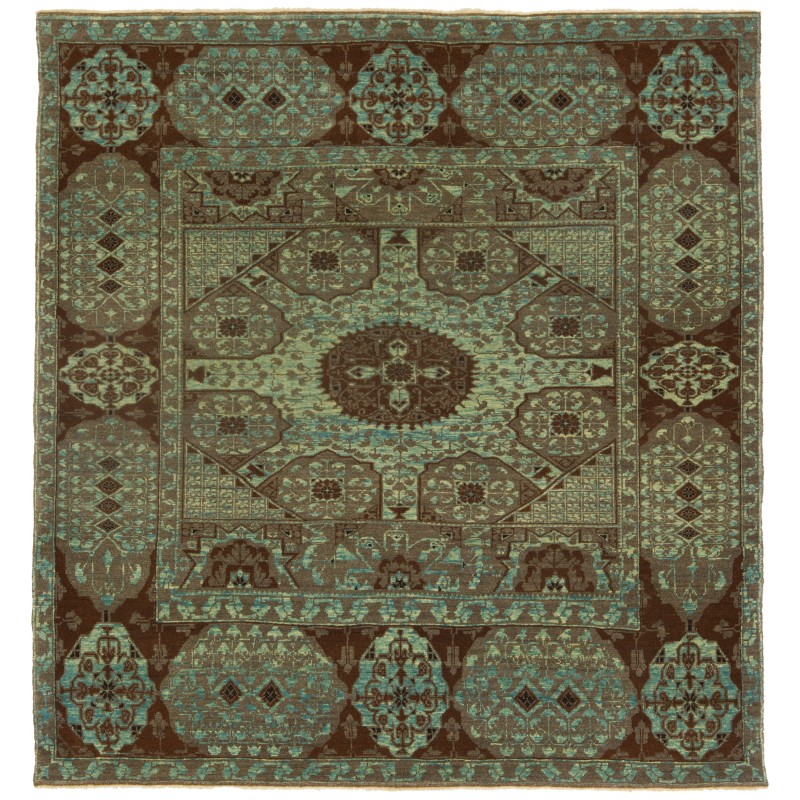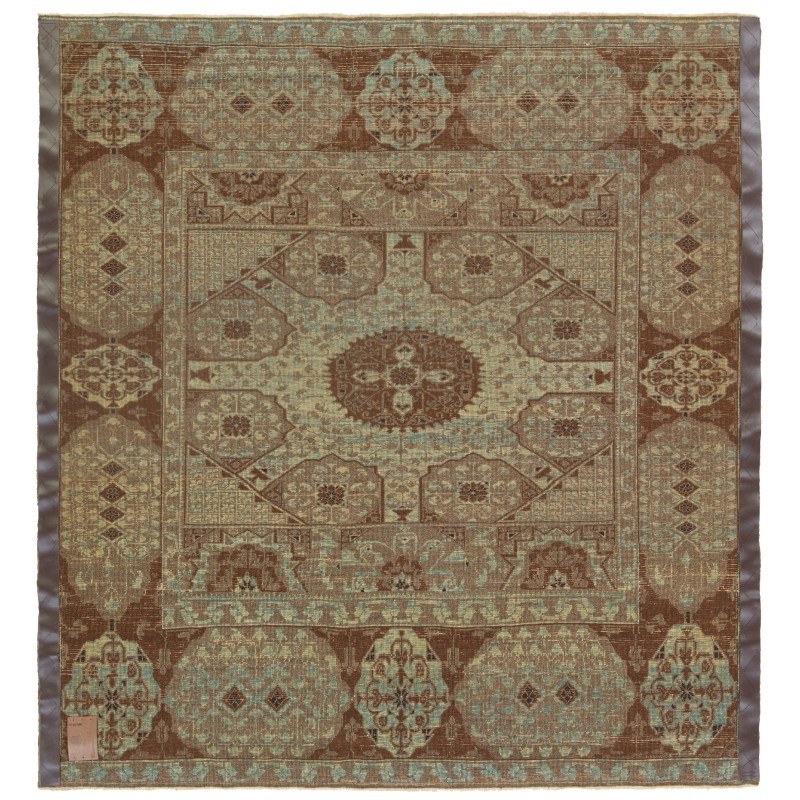



- Stock: In Stock
- Model: C50331
- サイズ: 157cm x 148cm
- Weight: 6.70kg
- SKU: ART331
この絨毯の情報源は、『Renaissance of Islam, Art of the Mamluks』、Esin Atil著、スミソニアン協会プレス、ワシントンD.C.、1981年、No.125です。この絨毯は、エジプト・カイロのマムルークスルタンからの15世紀後半のカップモチーフデザインの絨毯です。ワシントンD.C.のテキスタイル博物館、R.16.1.2で展示されています。この絨毯のレイアウトは、ほぼ正方形の小さなマムルーク絨毯の特徴です。広いフレームがフィールドを囲み、中央の正方形を上下に挟んだ長方形パネルからなる水平なユニットに分かれています。長方形パネルの高さは正方形の約1/3であり、フレームの幅と等しいです。中央の正方形の角は三角形に切り取られ、緑地の八角形を作り出します。この八角形には青い多葉のメダリオンがあり、その中心には多重の花弁がある星が含まれています。星の腕から外側に広がる花のモチーフが、星と多葉のメダリオンの間の領域に存在します。八角形の角には赤地の8つの孤立した不規則な多角形があります。これらのユニットはそれぞれ、腕と角から生えているピラミッドスプラスのモチーフを囲む正方形で飾られています。八角形のフィールドは、同様のピラミッドスプラスの飾りが八角形の周りに配置された8つの茎付きカップから生えているように見えます。角の三角形には、各セグメントにスタイライズされた蓮の花(またはフルール・ド・リス)の格子模様があります。絨毯の構成的なレイアウトは、同様の比率と内部区分を示す彩飾の扉絵に似ています。幾何学的な要素から成る放射状のデザインと花のモチーフは、マムルーク時代の写本、金属工芸品、ガラス、陶磁器、木工、織物などに見られるマムルーク美術の特徴的な要素です。中央の正方形に描かれている茎付きカップは、サキの紋章から着想を得たものと思われます。ここでは、カップは装飾的な要素として使用されており、紋章として特定されるものではありません。同じ装飾モチーフはベルリンの絨毯にも見られます。私たちのデザイナーは、この絨毯のデザインを解釈し、柔らかい色合いを選んでいます。
The source of the rug comes from the book Renaissance of Islam, Art of the Mamluks, Esin Atil, Smithsonian Institution Press, Washington D.C., 1981 nr.125. This a rug with a cup motif design late 15th-century rug from Mamluk Sultane of Cairo, Egypt. It is exhibited at the Washington D.C. The Textile Museum, R.16.1.2 . The layout of this rug is characteristic of the smaller, almost square Mamluk carpet. A wide border encloses the field, divided into horizontal units consisting of a central square flanked above and below by rectangular panels. The height of the rectangular panels is approximately one-third that of the square and is equal to the width of the border. The corners of the central square are cut into triangles, creating an octagon with green ground. The octagon contains a blue polylobed medallion, which encloses an eight-pointed star with a multipetaled rosette in the core. The area between the star and the lobed medallion has floral motifs springing outward from the arms of the star. The angles of the octagon bear eight isolated and irregular polygons with a red ground; each of these units is adorned with a multipetaled rosette enclosed by a square with papyrus motifs springing from its sides and corners. The field of the octagon is filled with similar papyrus sprays, some of which appear to grow from the eight stemmed cups placed between the polygons. The triangles in the corner bear a checkerboard pattern with a stylized lotus blossom (or fleur-de-lis) in each segment. The compositional layout of the rug is reminiscent of the illuminated frontispieces, which reveal similar proportions and internal divisions. Radiating designs of geometric components filled with floral motifs are a characteristic feature of Mamluk art, as observed in manuscripts, metalwork, glass, ceramics, woodwork, and textiles of the era. The stemmed cups represented in the central square appear to have been inspired by the blazon of the saqi. Here, the cups are used as a decorative feature and cannot be identified as blazons. The same decorative motif is found on a rug in Berlin. Our designers interpret the design of the rug and soft colors are chosen for this rug.
私たちが作ったオリジナルの絨毯です。昔の作り方、染め方全て守って明日のアンティーク絨毯を眼材しています。
この絨毯作るのに全部で 4 色使っています。
- Rare Grey 105 (羊そのままの色)
- Moss Green 27 (トウダイグサ - 藍)
- Natural Wool Color 37 (羊そのままの色)
- Dark Brawn 316 (羊そのままの色)
上の番号は私たちのカラーコードです。()の中は、主な草木染めの材料です。
